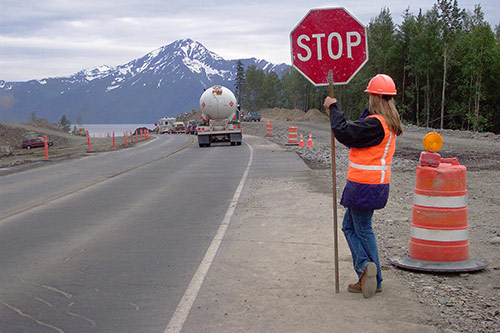
In a work zone, drivers should always pay attention to roadway signs, construction workers on or near the road and the road’s surface.
Drivers like traveling on a well-kept road. A smooth road with no potholes, bright yellow and white lines, and clear and concise signage helps drivers do their jobs well. However, getting that well-kept road takes time, and more often than not, a lot of construction.
Highway construction zones are dangerous to drive through at any time of the year, but the amount of construction zones increase during the warmer months. According to the National Work Zone Safety Information Clearinghouse, there were 3,261 fatal crashes involving large trucks in 2010 (the most recent data available.) Out of those crashes, 114 were located in a work zone; a significant decrease since 2005, when 289 trucks were involved in work zone accidents. While this is a noteworthy achievement for the trucking industry, striving for safety is a long-term commitment for you, your drivers and your company.
Pay attention and stay alert
While you always want to be alert and aware while driving, it is especially important in a construction zone. According to the Federal Highway Administration (FHWA), everyone is responsible for work zone safety. Planners and engineers are responsible for ensuring the work zone is operating properly and drivers are responsible for traveling safely through construction zones. In a work zone, drivers should always pay attention to roadway signs, construction workers on or near the road and the road’s surface.
Roadway signs are meant to notify and give direction to drivers. Pay attention to these signs. They include important information about the route ahead. Be aware of the possibility of decreased speed, a lane change or detour.
Construction workers should not need to worry about on-site fatalities or injuries. Stay alert for roadway workers, and encourage your drivers to slow down and use caution when entering, traveling through or exiting a construction zone. Data has shown drivers are more likely to speed the longer they travel in a construction zone.
Pay attention to the road surface. In a construction zone, there is always a possibility for debris. If the road is being mended, repaved or widened, the road’s surface is more likely to be uneven. Be cautious and aware of any anomalies appearing in the roadway such as potholes or miscellaneous debris.
Construction zone layout
While each individual construction zone differs, knowing the general layout of construction zones helps your drivers plan for their next maneuver. Each construction zone is made up of five areas that are designed to keep all workers and motorists safe.
- Advance warning areas: Alert drivers on what to expect and allows enough time to adjust driving.
- Transition areas: Allow drivers to move to a new path including merging lanes together.
- Buffer areas: The open space between the transition area and the work zone, which gives space between drivers and workers before traffic actually reaches the active work area.
- Work areas: Closed to traffic and houses workers, equipment and building materials. More often than not, only a barricade is separating the traffic from the worker and machinery.
- Termination areas: Provide a short distance for traffic to clear the work area and return to normal traffic patterns.
Driving strategies
When traveling through a construction zone, drivers should be aware of some driving strategies that will ensure greater work zone safety.
- Slow down. Always pay attention to the speed limit, especially in construction zones. Some states have increased fines for speeding. Do not be intimidated by others behind you encouraging you to drive over the speed limit.
- Don’t tailgate. Double the following distance to allow more time to stop or safely react in case of an emergency.
- Stay a safe distance away from construction workers and their equipment.
- Watch for stopped traffic.
- Merge as soon as possible. Don’t wait until the last minute to merge into another lane. If all individuals on the roadway cooperate, traffic flows well and efficiency improves.
- Do not block traffic. This is a traffic violation in most states and does encourage road rage and aggressive driving in other drivers.
- Plan ahead. Drivers should plan ahead and expect delays. Highway agencies use different methods to inform drivers about work zone delays. However, they will often suggest a detour that will allow your drivers to avoid the work zone.
For more information on driving through construction zones and other safety tips, check out our Safety Solutions video “Driving Safely Through Highway Work Zones.”